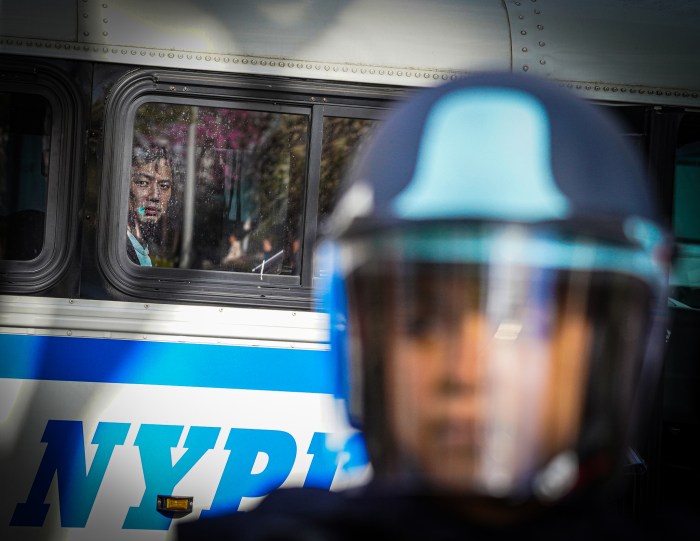By Ayala Ben-Yehuda
Several dozen elderly and disabled residents of the Scheuer House independent living facility in Bayside marched Tuesday across the intersection where a resident was killed to demand increased traffic controls at the crossing.
Chanting “What do we want? We want a light for a life!” residents walked around 26th Avenue and Corporal Kennedy Street, where 63-year-old Phyllis McLean was fatally struck in November as she tried to cross the street in her motorized wheelchair.
McLean was first hit by a Toyota making a right onto 26th Avenue from Corporal Kennedy Street, then pushed by the impact into a Jeep waiting to make a left from Corporal Kennedy Street onto 26th Avenue, police told the TimesLedger at the time.
“You cannot get across this street,” said Louise Sepe, a four-year resident of Scheuer House who helped organize Tuesday's rally. “You're taking your life in your hands.”
Since the accident, the city Department of Transportation has put a “yield to pedestrians” sign and added a time delay to the changing of the lights at the intersection, according to Sepe, but residents said the changes have not made them feel safer.
“I'm tired of being a crossing guard,” said six-year Scheuer House resident Suki Acquah, who regularly reminds drivers from her wheelchair that she has the right of way to no avail.
Residents, along with City Councilman Tony Avella (D-Bayside), have long been demanding a left turn arrow and increased delays between light changes.
“With the senior residents here, they need some time,” said Avella, who has proposed that signals temporarily stop traffic from all sides at the intersection to allow people to cross.
Yoomin Chang, a social worker at Scheuer House, said most residents had no one to help them cross the street.
“Some people have a home attendant, but most of them don't have anybody,” she said.
DOT conducted a study of the intersection in April 2002, several months before McLean was killed, but found that not enough left turns were made to warrant a left turn signal there, said Department of Transportation spokesman Tom Cocola.
Cocola said it was the agency's policy not to study intersections more than once in the span of 18 months and that another study would be conducted in October.
“Enough is enough,” said Avella, who has introduced legislation that would change the criteria by which intersections are evaluated for traffic lights.
“It's a no-brainer,” said Avella. “How many times do you have to study an intersection?”
Avella said his legislation was stalled in the Council's Transportation Committee because DOT was “scared to death” that the bill would take away the agency's authority in those matters.
Cocola called McLean's death “an unfortunate accident” but pointed out that the driver who struck her was making a right turn, not a left.
“Whenever you have an accident or crash or tragedy, inevitably people will automatically say that the DOT has to do something,” said Cocola.
Cocola said most accidents were caused by a lapse in three factors: engineering of a street, enforcement and education.
“You can perfectly engineer a street and an accident can still occur,” said Cocola. “We think that the job of assigning the proper design of intersections should be left to engineers – not based on political whim.”
After the rally, residents packed the Scheuer House library to watch Chang and Avella put up a plaque renaming the room after McLean, whom Chang said was “instrumental” in starting the library.
Paintings by residents and a certificate from Borough President Helen Marshall honoring McLean decorated the walls of the room.
“She used to go with her wheelchair from library to library getting large print books,” said resident Helen Gottlieb. “She worked endlessly.”
Reach reporter Ayala Ben-Yehuda by e-mail at Timesledger@aol.com or call 718-229-0300, Ext. 146.































